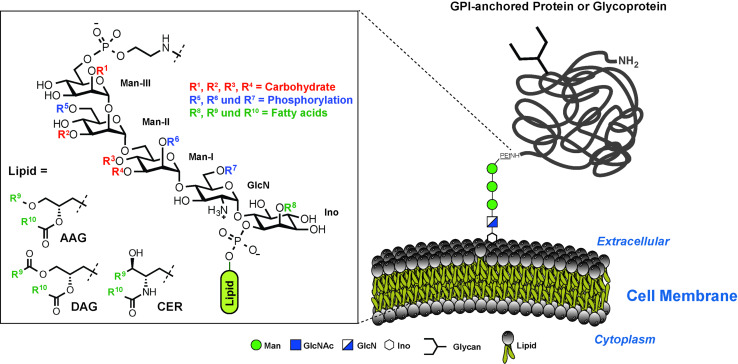GPI-anchor Analysis Service
The GPI anchor is a complex glycosphingolipid that post-translationally attaches to the C-terminus of proteins. The fatty acid chains of the GPI anchor are inserted into the membrane, serving as an anchor for the protein. Creative Proteomics specializes in high-quality GPI-anchor analysis services, covering identification, quantification, and characterization, offering valuable insights into your protein research initiatives.
What is GPI-anchor
GPI-anchored proteins form a distinctive category of membrane proteins, distinguished by their unique membrane attachment through a glycosylphosphatidylinositol (GPI) anchor. This post-translational modification offers a specialized mechanism for tethering proteins to the outer leaflet of the cell membrane in eukaryotic cells. Crucial for diverse cellular processes, GPI-anchored proteins possess structural and functional characteristics that distinguish them from other membrane proteins.

Fig.1 Schematic of GPI-anchored protein (Garg, M.; et al. 2016)
The initiation of GPI anchoring transpires in the endoplasmic reticulum through the synthesis of a preassembled GPI anchor. This anchor comprises a lipid tail (phosphatidylinositol), a glycan core, and ethanolamine phosphate. During protein synthesis, the GPI anchor is added to the C-terminus of the nascent polypeptide chain. Post-translational modifications ensue, encompassing the cleavage of the C-terminal signal sequence, liberating the GPI-anchored protein into the endoplasmic reticulum lumen. Subsequent transport to the cell surface involves the incorporation of the GPI anchor into the outer leaflet of the cell membrane.
Applications of GPI-anchor Analysis
- Cell Signaling Study
GPI-anchored proteins participate in various cellular functions, including cell adhesion, signal transduction, and immune response. Their localization within lipid rafts, membrane microdomains enriched in cholesterol and sphingolipids, is essential for their roles in signaling cascades. - Disease Research
Certain pathogens exploit GPI anchoring to attach virulence factors to their surfaces, contributing to pathogenicity. Understanding the principles of GPI anchoring has implications for disease research, as aberrations in GPI metabolism are associated with human diseases, such as paroxysmal nocturnal hemoglobinuria (PNH). - Drug Development
GPI-anchored proteins are potential targets for therapeutic interventions, making them subjects of interest in drug development.
Our Service
Creative Proteomics has advanced protein detection technologies and can provide customized services to researchers and scientists to help them reveal the complexity of PTM using powerful mass spectrometry technologies. Our services are thoughtful and detailed and the process of GPI-anchor analysis service is as follows:

Fig.2 GPI-anchor analysis workflow
- Sample Preparation
Proper extraction and preparation of proteins from biological samples to ensure preservation of GPI-anchored proteins. - GPI-anchor Enrichment
Enrichment techniques are employed to isolate GPI-anchored proteins or peptides. This step is crucial as GPI-anchored proteins are often present in low abundance compared to unmodified proteins. - Detection
WB, protein microarrays and LC-MS/MS are powerful tools for the identification and quantification of GPI-anchored peptides, and they provide detection information that facilitates a comprehensive analysis of GPI-anchor. - Bioinformatics Analysis
Advanced bioinformatics tools are used to analyze data, identify GPI-anchored peptides, and map these modifications to protein sequences. - Result Delivery
After professional data analysis, we deliver results quickly and consistently.
Creative Proteomics brings a wealth of experience to the field of protein research. Our comprehensive services and products cover the entire spectrum of utilizing suitable and efficient gateways. Utilizing our proprietary platform, we have successfully implemented many proteomics research projects. If you are interested, please contact us for more information and a quote.
Reference
- Garg, M.; et al. Glycosylphosphatidylinositols: Occurrence, Synthesis, and Properties. Reference Module in Chemistry, Molecular Sciences and Chemical Engineering. 2016

